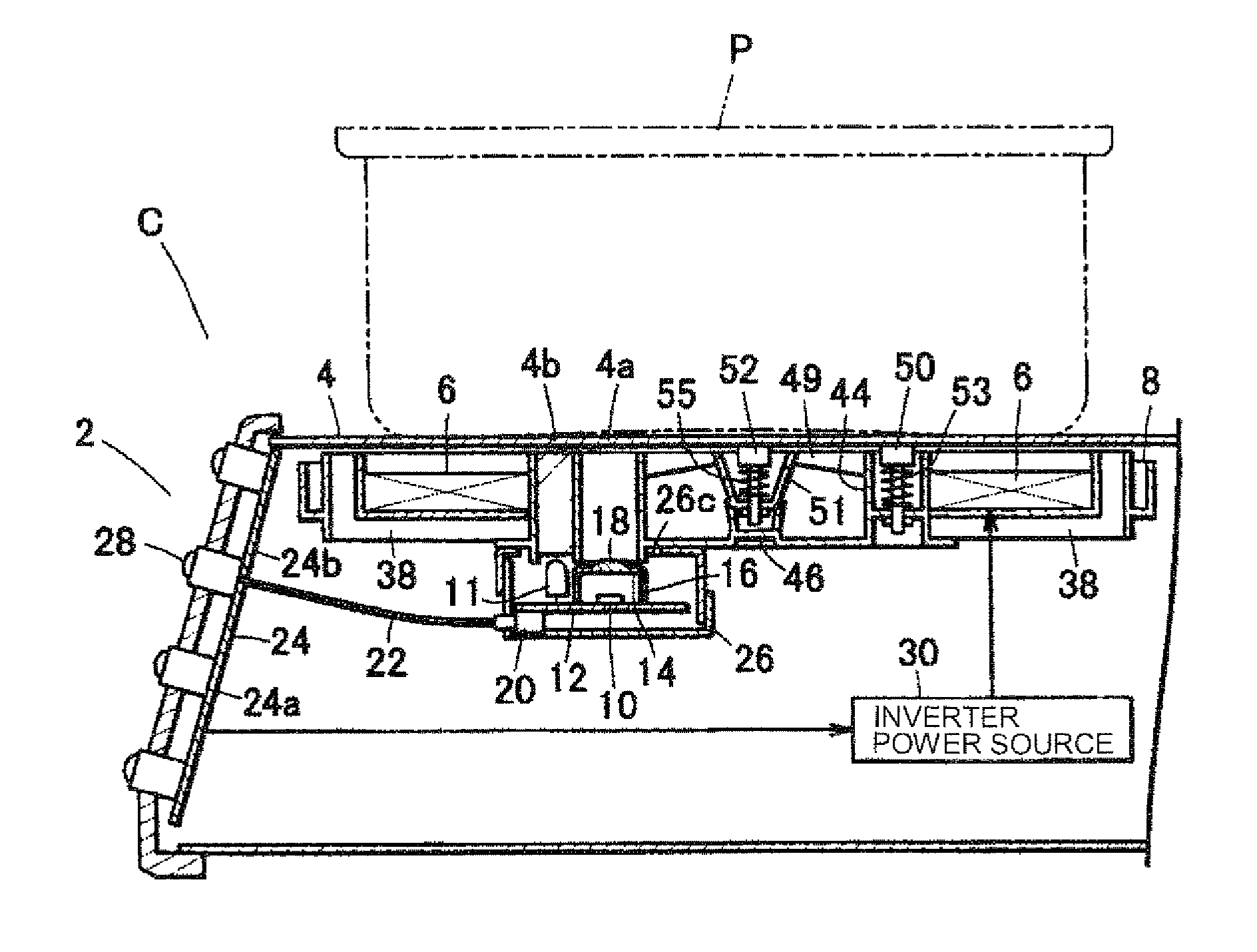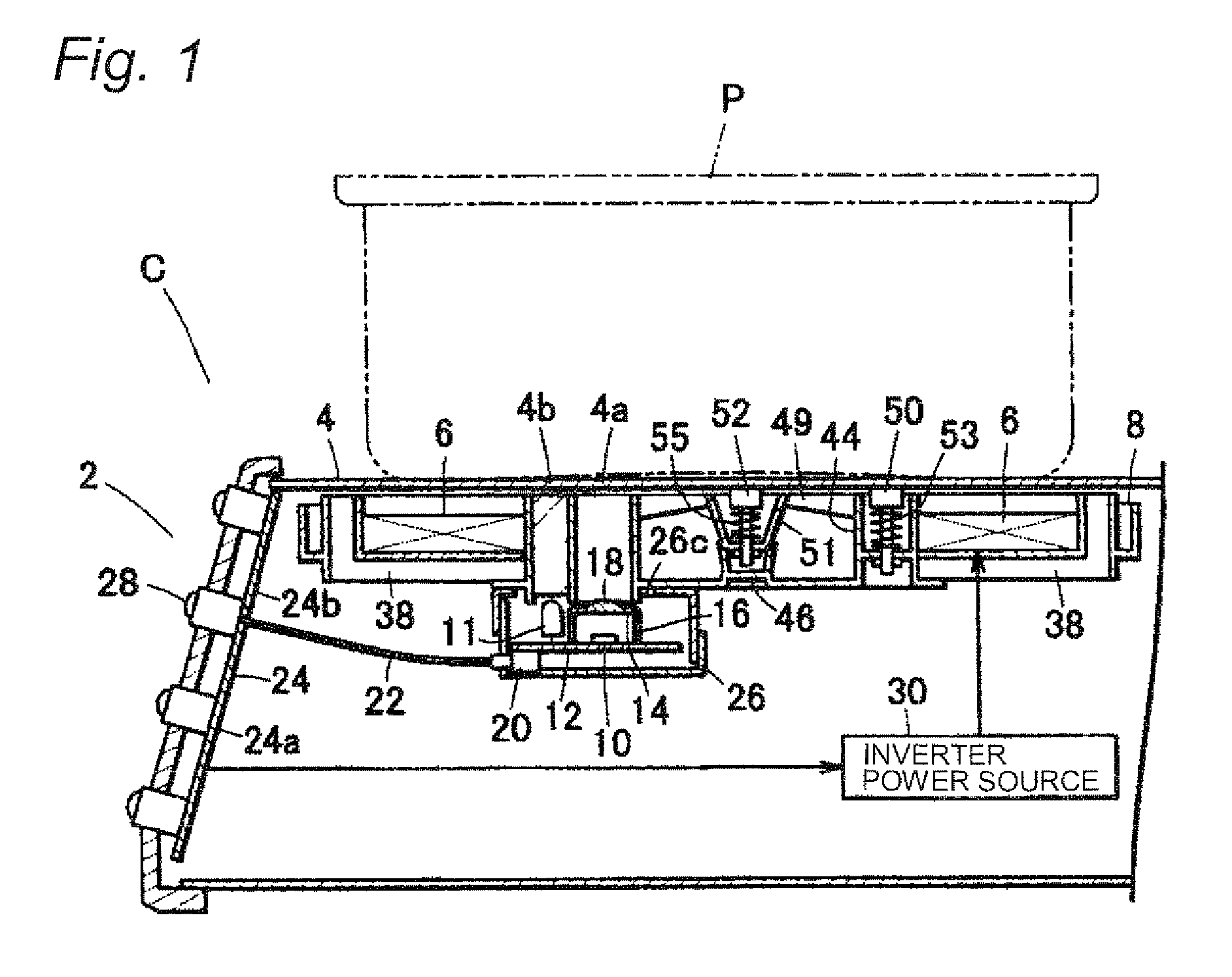Induction heating appliance for cooking
a technology for induction heating appliances and cooking containers, which is applied in the direction of induction heating, electric/magnetic/electromagnetic heating, electrical apparatus, etc., can solve the problems of inability of infrared sensors to detect the temperature of cooking containers properly, the position of infrared sensors is hardly ascertained with eyes, and the infrared sensors are not properly detected. to achieve the effect of increasing the usability of induction heating appliances
- Summary
- Abstract
- Description
- Claims
- Application Information
AI Technical Summary
Benefits of technology
Problems solved by technology
Method used
Image
Examples
first embodiment
[0027]FIG. 1 illustrates, in a schematic sectional representation, an induction heating appliance C for cooking according to a first preferred embodiment of the present invention. As best shown in FIG. 1, the induction heating appliance C of the present invention includes a body 2 forming an outer shell, a top plate 4 mounted on a top area of the body 2 to place thereon a cooking container P such as, for example, a pan, and a generally disc-shaped heating coil 6 arranged beneath the top plate 4 for generating high frequency magnetic fields.
[0028]The top plate 4 referred to above is made of a light transmissible, insulating material such as, for example, crystallized ceramic and is formed into a plate shape. The top plate 4 has a table top surface, or a rear surface opposite to the table top surface, provided with a heating area 5, the perimeter of which is indicated to show where a cooking container P has to be placed (see FIG. 2). The heating area 5 is defined by a colored, for exa...
second embodiment
[0072]FIG. 7 illustrates a fragmentary top plan view showing the top plate employed in the induction heating appliance for cooking according to a second preferred embodiment of the present invention. FIG. 8 illustrates a fragmentary enlarged diagram showing the infrared sensor and its vicinity in the induction heating appliance for cooking. Component parts referred to hereinafter, but similar to those employed in the previously described embodiment of the present invention are designated by like reference numerals and, therefore, the details thereof are not reiterated for the sake of brevity.
[0073]Referring now to FIG. 7, a center front portion of the top plate 4 showing the heating area 5 has its rear surface provided with the black colored, printed thin film 7c (see FIG. 8) capable of transmitting light therethrough and formed with the infrared sensor display window 4g and represents a generally rectangular shape when viewed from above. In FIG. 8, a region indicated by A represent...
third embodiment
[0076]FIG. 9 illustrates a fragmentary top plan view of the top plate employed in the induction heating appliance according to a third preferred embodiment of the present invention. FIG. 10 is a fragmentary enlarged view showing the infrared sensor and its vicinity in the induction heating appliance shown in FIG. 9. Component parts referred to hereinafter, but similar to those employed in the previously described embodiment of the present invention are designated by like reference numerals and, therefore, the details thereof are not reiterated for the sake of brevity.
[0077]Referring to FIG. 9, the rear surface of the top plate 4, which shows the presence of the heating area 5, has a black colored, printed thin film 7c (see FIG. 10) capable of passing light therethrough, which is provided over substantially the entire surface thereof. On the other hand, the table top surface of the top plate 4 opposite to the rear surface referred to above is formed with an infrared sensor display wi...
PUM
 Login to View More
Login to View More Abstract
Description
Claims
Application Information
 Login to View More
Login to View More - R&D
- Intellectual Property
- Life Sciences
- Materials
- Tech Scout
- Unparalleled Data Quality
- Higher Quality Content
- 60% Fewer Hallucinations
Browse by: Latest US Patents, China's latest patents, Technical Efficacy Thesaurus, Application Domain, Technology Topic, Popular Technical Reports.
© 2025 PatSnap. All rights reserved.Legal|Privacy policy|Modern Slavery Act Transparency Statement|Sitemap|About US| Contact US: help@patsnap.com



